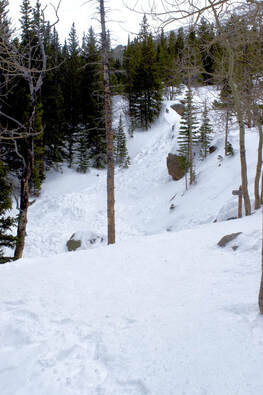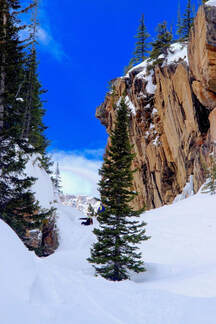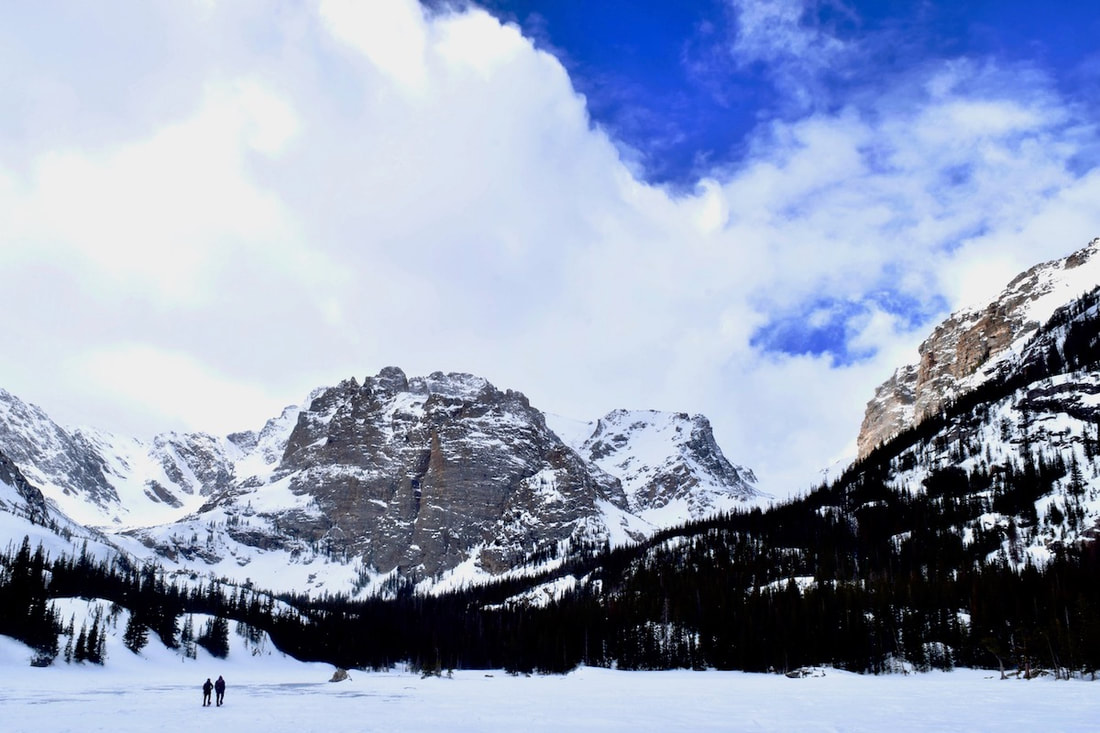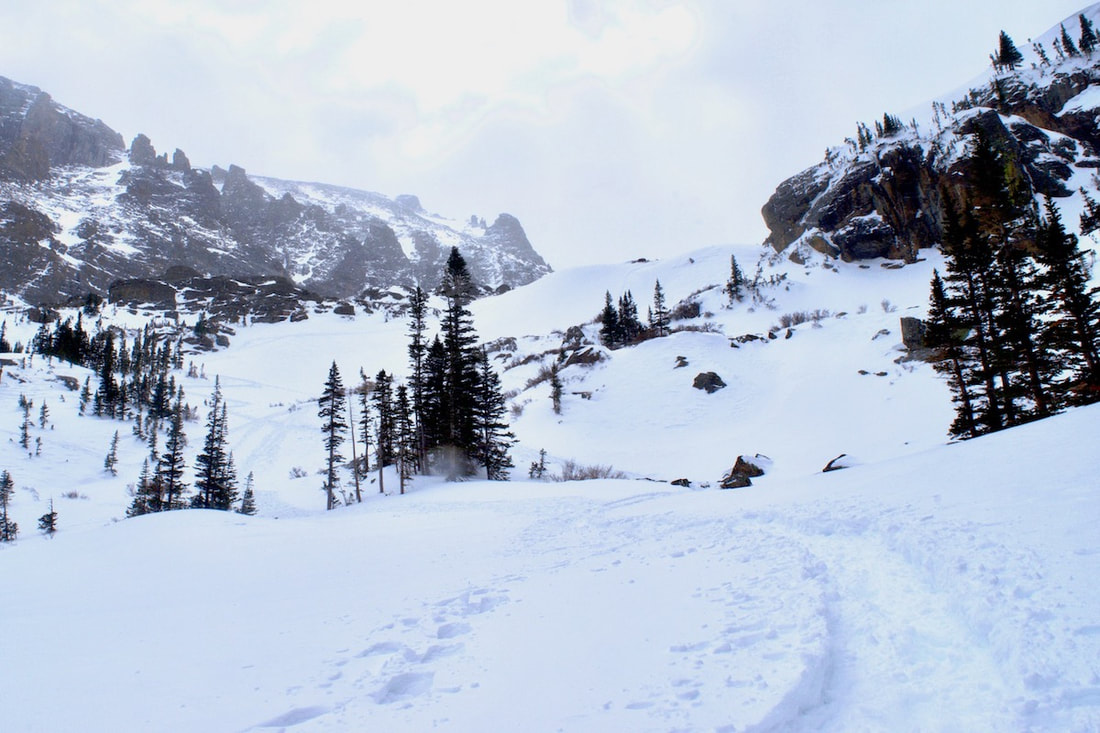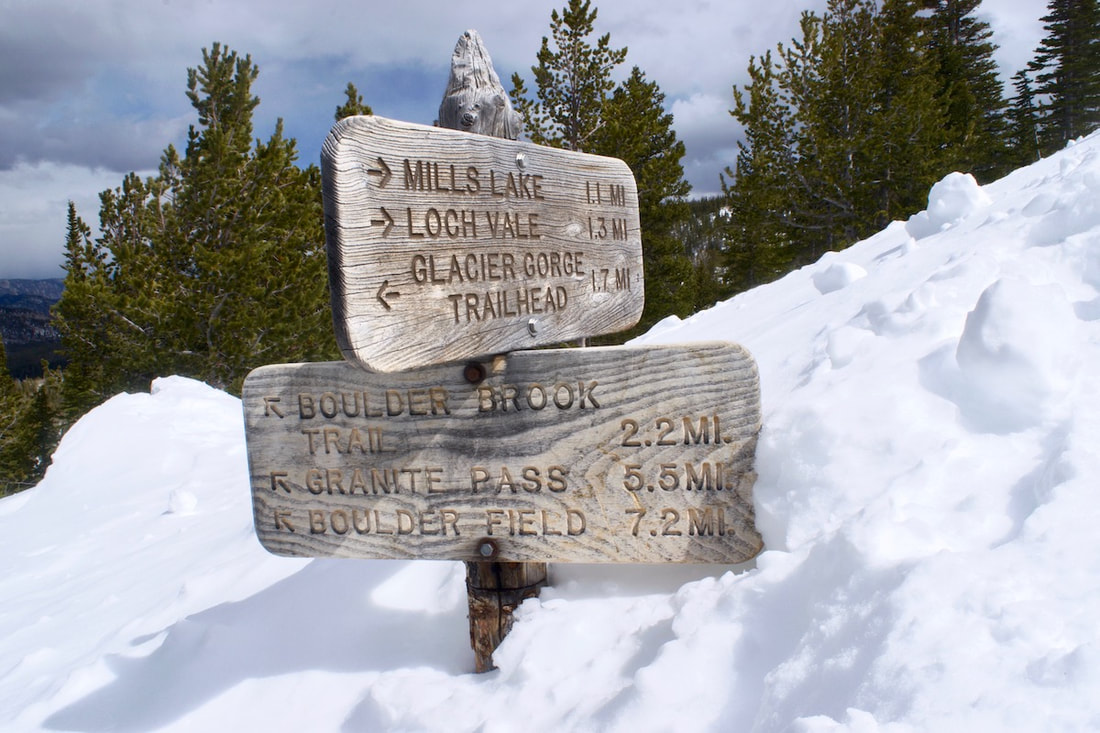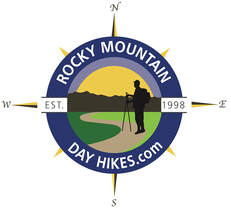|
Notes from the
Trail |
|
Two days after the Spring Equinox, Mother Nature announced spring had arrived in the mountains of Rocky Mountain National Park and the Estes Valley with a booming afternoon thunderstorm that resulted in a small amount of spring snow. There were already signs of spring around though. RMNP Trails was reporting the Hooker’s Townsend Daisy (Easter Daisy) already in full bloom along the sunny and low elevation Lumpy Ridge, there were reports of a bear in a tree in the Riverside Dr area, an aspen patch not far from the Beaver’s Meadow Visitor Center had started to bloom catkins, and chipmunks appeared around my bird feeder. The weather report is calling for more snow on Friday. It must be spring time in the Rockies. The trails in the lower montane regions of the Park are treacherous right now. The packed snow on the trails melt into a slush during the day but freeze into a glaze overnight. Either micro spikes or ice skates are needed. And if the ice does melt off, it often leaves a slimy muddy patch to slip and slide on, challenging ones aerobic agilities. If you really want a taste of spring now, it might be best to head for a trail down around Lyons. Otherwise, just head back up into winter in the subalpine Bear Lake area. That’s where I went. I wanted to make another try at Timberline Falls. On the morning I had planned to journey up, the skies were overcast and not looking good. So I thought I would wait a day for improved conditions. But, of course, by afternoon the
Even though it looked like winter, the day was warm and the conditions were starting to change. A squirrel scurried in front of me across the snow. It stopped briefly to consider me, but it seemed to be on a tight schedule and quickly disappeared. I trekked along in this first portion of the hike lost in thought about the different ways people connect with nature. For some, a journey into the high mountains is held with a quiet reverence. But children like to play in nature and seldom show such reverence. I thought about how reverence for nature seems to develop for them through their playfulness.
I resumed my hike up the snow filled drainage when a couple of skiers swooshed down, working to maintain control. They stopped briefly uphill from me and I asked them where they had skied from. They had gone up to Andrews Glacier but decided the conditions were not favorable, so they turned back. They had had a good day
led to the base of the drift where someone with snow shovels had mined out snow caves. The opening of one I checked out was small and I peaked in to see a small room that might cozily fit three or four people. Turning back to the main snow trail, another skier slid to a stop and asked how big the snow caves were. He was carrying an overnight pack and had spent the night out somewhere on the far end of The Loch. It had been a good night with out much wind. I It was practically a windless day at The Loch and I found a seat beneath one of the wind twisted Bristle Pines and watched the clouds shift around. What ever blue sky there might have been over the peaks earlier was quickly disappearing. I pulled some I packed up my pack and finished my trek to the snow covered Timberline Falls. The clouds were moving down on the peaks now so I turned to head back.
0 Comments
 Why is the return always longer when it’s not? This last week, after the snowbomb cyclone that hit the high plains with a vengeance, I tried out Wild Basin. I had not been there yet this winter and I found the road closed at the entrance gate; that would add some distance to the destination. The road was well covered with snow though, and the trail had not been packed down too much yet. I shoed around Copeland Lake and along the lower section of the road, going past the mid way gate that is the usual winter parking area. The walk to the Thunder Lake trailhead was an enjoyable travel, with a stop along the river in one of the few places that had open water. There were fluffy piles of snow perched on top of boulders and thin slices of ice where the boulders met the surface water. The open water maneuvered around the boulders and sounded a little like a summer mountain stream, pleasant. It was quite amazing to look around and see all the water that was about to melt and run down toward the Mississippi Delta and think of all of the flooding that it will do along the way over the next couple of months (there’s a report coming out of Chatham in the UP of Michigan of snow depths over 200 inches, yes, over 16 ft of snow, holy wuh!!!).  I past by the Finch Lk trailhead quickly and then rounded the corner to the Thunder Lk trailhead. I had a good pace going and it didn’t seem to take too long to get there. I walked onto the little foot bridge that crossed the small creek at the trailhead and stopped to see if there was any open water, but there was not, it was all snow. I continued into the trees. A skier somewhere up ahead was breaking trail. He had passed me back on the road and when he passed, I notice he was not carrying a day pack. But peeking out of his back pocket, I could see the top of a soda can and by the color of it, it looked to be Dr Pepper. At least he was packing some energy. I tried to stay out of his tracks because I have heard somewhere that snowshoes can wreck a good ski track.  My friend, the aspen My friend, the aspen I noticed all of the familiar spots along that lower section of the trail and that some of the understory trees were still holding snow on their branches, while all the tall skinny trees that were being swayed by a warmish wind higher up had already lost their snow. I branched off to the Lower Copeland Falls but found it covered with bunches of snow all over. On the way up to the upper falls, I stopped and looked at some aspens. Most of them were showing red tips that had emerged on the end of the branches. They were thinking about summer also.  I arrived at the upper falls and found more open water from the little bit of turbulence coming off falls, covered over with deep snow. I remembered being here during the summer and watching a pair of Ouzel birds that habitated here. At that time, the falls were roaring with summer runoff and the Ouzels kept flying to a spot on the small cliff that embraces the falls. I assumed they had a nest there. While I sat there watching them busily catching food in the water below the loud falls, often diving under the water, I thought about how the only sound the young would ever hear until they flew from the nest would be the roar of the fall, which I thought was loader than city traffic. It’s a very sustained loud sound next to the falls.  Upper Copeland Falls Upper Copeland Falls I imagine they would know that river sound so well that they could heard different sounds coming from the river that I would never notice. Although John Muir heard those sounds when he was writing about the Sierra Ouzels: “[H]is music is that of the streams refined and spiritualized. The deep booming notes of the falls are in it, the trills of the rapids, the gurgling of margin eddies, the low whispering of level reaches, and the sweet tinkle of separate drops oozing from the ends of mosses and falling into tranquil ponds.” ~ Muir 1894 (I really need to listen to the sounds of water falls better!!) But I didn’t see any Ouzels flying around today and I wondered what they did during the winter (John Muir’s Ouzel, now officially known as the American Dipper, migrate altitudinally, that is moving to lower elevation during the winter, so says audubon.org). While I was at the falls, I had a drink of water and a bite to eat and I wondered how much farther I should go. I traveled up the trail a little further, but not as far the Calypso Cascades. By the way the snow was covering over the river down lower, I figured they were likely covered with snow also and hardly recognizable.  I was stooped down in the snow photographing a small patch of open water when the skier that had been breaking trail skied past on his return. I asked him if had made to the falls. He had, but was gone before I could ask how they were. I decided it was time to turn back also. Retracing the tracks the skier and I had made, we ran into another set of tracks that only went as far as the lower falls. Having already pass through all of this, I didn’t feel a reason to stop, I was more focused on the return. I traveled as if I were in a hurry to get somewhere. And this is where the going seemed to get longer. Even though I’m sure I was not taking as much time, all of a sudden, the road seemed to be twice as long as before and I wondered in the moment, numerous times, why this was. The day had grown warm and the snow had become soft. I traveled with my coat unzipped and my hat in my hand. As I past people who were just heading out, so late in the day it seemed, they all gave me a smile. I gave them a friendly hello back, but kept up my pace. It seemed to be taking forever to get to Copeland Lake. But then, there it was and though I hustled around, I felt like I was dragging. Finally, the parking area and then the car. After taking the snowshoes off, I hopped into the front seat and happened to catch a glimpse in the rearview mirror, and then took a closer look. My strands of hair looked as if they had just gone limp from a jolt of electric shock, they were sticking out every which way. And just like the people that had passed me, I smiled. “I swear I begin to see little or nothing in audible words, All merges toward the presentation of the unspoken meanings of the earth, Toward him who sings the songs of the body and of the truths of the earth, Toward him who makes dictionaries of words that print cannot touch. “I swear I see what is better than to tell the best, It is always to leave the best untold. When I undertake to tell the best I find I cannot, My tongue is ineffectual on its pivots, My breath will not be obedient to its organs, I become a dumb man.” Walt Whitman, from A Song of the Rolling Earth, Leaves of Grass “Moreover, I find that though I have a few thoughts entangled in the fibers of my mind, I possess no words into which I can shape them. You tell me that I must be patient and reach out and grope in lexicon granaries for the words I want. But if some loquacious angel were to touch my lips with literary fire, bestowing every word of Webster, I would scarce thank him for the gift, because most of the words of the English language are made of mud, for muddy purposes, while those invented to contain spiritual matter are doubtful and unfixed in capacity and form, as wind-ridden mist-rags.” John Muir in a letter to Jeanne C. Carr, a former professor  These are the struggles that two great nature writers, a generation and a continent apart, find themselves in; words that are not adequate to express what they experience in nature. And yet Whitman and Muir do write, splendidly, exquisitely. How can I possibly think that I will find the words in these notes that I jot down about my experience in nature? I do not. And while I’m under no allusion that my words will do anything but possibly get across some notion of what my experience in nature is, I will also write because, what the heck, what I experience in nature is worth the try. I cross over the hump of piled snow left by the snowplow in front of the gate that closes Trail Ridge Road at Many Parks Curve. I clip into my skis and follow the snow path made by a couple of snowshoers. Fresh snow has fallen and avalanches are crashing down all over the state, closing roads that haven’t been shut down from the overpowering snow slides in over a half a century. But here, it’s quiet, not even wind music, and I’m caught up with making my skis function. Because I still ski on skis that need wax for propulsion, and because I forgot to tend to my skis by putting on new wax before I left and so I am going with whatever wax was left on the skis from my last outing, and because this snow can be so difficult to wax for which can cause the skis to either not grip and slip too much or form large clods of snow that hang off the bottom of the skis making them impossible to move, I wonder about how well things will go. But so far, everything seems fine. So I keep moving forward. The new snow is warm snow; good snow for building snow forts and stockpiling a collection of snowballs to be lobed at others. But I am an army of one fighting against an army of none, so the effort is left behind. There are views down into Horseshoe Park, but the encompassing peaks are hidden by low clouds. The somewhat wetter snow clings easily to the trees, and though it is fresh, it seems to hang on the branches like damp laundry.  Of course, the very thing that Whitman and Muir find so impossible to write about is not simply describing the beauty they see in nature, but the spirit or essence of nature, the internal eternal that one experiences in nature. Nature is more than beauty, it is a life unto its own and when we walk into nature, we are entering a world that already exists, we are walking into a life that knows how to take care of itself, and does so with such exquisite beauty and grace that it feels magical. We are left in wonder. There’s an outward bending curve in the road as it follows the contour of the hillside and it would seem the wind must always blow around this bend because, despite the many feet of snowfall that has accumulated all around, there is pavement showing here. And indeed, the wind is now gusting snow into my face and I lower my head letting the top of my hat take the pelting. But not long after, back in the trees and no longer in wind, the snowshoe tracks lead off to the outter edge of the road where they sit and rest on a rock wall. But the snowshoers have had enough and their tracks head back, leaving me to break a new track. Without even the snowshoe tracks to keep me company, the surroundings now seem quieter and I begin to trace a skinny trail as I head farther up the road.  “I swear the earth shall surely be complete to him or her who shall be complete, The earth remains jagged and broken to him or her who remains jagged and broken.” ~ Whitman I fall into a steady rhythm and my eyes focus primarily on the forward placement of the skis, occasionally looking up to track my progress. But my mind wonders into all sorts of everyday thoughts. Fortunately, the extra work of making a new track forces me to take a few more breaks and I am given an opportunity to gander about while catching my breath. My mind also takes an opportunity to rest and soak in the silence and calm. This is what I came to find. The clouds dissipate some and the sunlight falls between the trees and lands gently onto the snow. Rocky Mountain National Park is remarkable, in part, because of the rapid rise in elevation. If a raven were to lift off from the top branch of a ponderosa pine at the Beaver Meadows Visitor Center and fly a straight line to the top of Flattop Mtn, that raven would have flown 8 miles and gained 4,524ft (if another raven also took flight from a nearby ponderosa and headed south for 8 miles, that raven would have to gain 6,459ft in order to land on top of Longs Peak). Over that short 8 miles, these two ravens would have flown over extremely varied terrain and vegetation, classified as the montane, the subalpine, and the alpine life zones. It is a quick lesson on the significance that elevation plays for life on this planet. During the winter, that elevation change plays out in snowfall amounts. On any given winter day, it would be possible to leave the beaver meadows area on a somewhat mild day with patches of snow caught in bushes and hiding in the shadows, and drive up the Bear Lake corridor into full on winter with many feet of snow. Thus becomes the dilemma for the traveler on foot. What foot gear do you use, because many trails can begin with not much snow, where micro spikes are good for ice patches on the frozen dirt trail, but farther up the trail there’s deep snow where skis or snowshoes are the thing to have on your feet. If you want to start on snow, there are basically three main ski corridors in the Bear Lake area. There’s the trial that goes up the Glacier Gorge and leads to MIlls Lake and the Loch, the short trail to Dream and Emerald Lakes that the photographers like to run up in the early morning hours to catch the gorgeous sunrises off of Hallet Pk, and the longer trail toward Flattop Mtn, Bierstadt Lake, and Lake Helene located below Notchtop Mtn. Generally speaking, if you are breaking trail after a fresh snow it can be pretty easy to know where the trail goes through the trees. However, there is one spot on the way to Lake Helene where trail location can be difficult. I followed some tracks that had lost the trail on my way over to Lake Helene. Quite a meander. I finally gave up and navigated my own way.  Looking into the upper Glacier Gorge from the Flattop Mtn trail Looking into the upper Glacier Gorge from the Flattop Mtn trail I began at the at Bear Lake parking lot at a lazy 10:00. The day was clear, warmish, and mostly calm with some breeze, and for most of the day I traveled without my hat and gloves on and my coat unzipped. Taking the Flattop Mtn trail from Bear Lake, I snowshoed on packed snow past the first cutoff for Bierstadt Lake at 10:20 and the next cutoff for Flattop Mtn at 10:40. At 10:50, heading toward Lake Helene now, I passed under ski tracks that were making turns coming down through the trees on my left, while the trees on my right opened up to views looking east all the way down to the meadows around Lake Estes. Longs Peak peaked through trees behind me from the south. Looking down over the view of the surrounding forest on this day, it looked almost like summer because all of the snow had fallen off the trees and was hiding below them. The only real sign of winter was a white dot surrounded by green pines. That dot was the ice and snow that covered over Bierstadt Lake.
windswept snow. Some call this the Flattop Drift and like skiing this hard pack snow. From this point, the traveler makes a bee line across this open section just above the tree line. The trail on the other side dips back into the protected trees. Finding that spot where the trail enters the trees can sometimes be difficult. If you are the first one out after a fresh snow, there will likely be others that will follow in your tracks. I guess it could be fun to take everyone on a wild goose chase in search of the trail. Or, you could just head off in the right direction. Notchtop Mtn comes into view. In the summer, the trail goes around Two Rivers Lake and you hardly notice the pond is there. But in the winter, that’s where you want to go. In fact, the photography is better from Two Rivers Lake than Lake Helene. Two Rivers is a bigger pond and sits back from Notchtop for a better photographic composition, whereas Notchtop soars over Lake Helene so much it’s hard to effectively get a good photograph of it all. Also the ice is better at Two Rivers Lake, maybe because it’s a deeper pond.
From Lake Helene, one does get a good view into the Ptarmigan Glacier basin, which Notchtop overlooks to the south. It’s a collection basin for snow and it looks like it’s going to be winter up there for a while. The wind plays with some snow dust on the Thin clouds had materialized overhead, but the midday sun was still doing its best to start the melting process. That seemed like an unlikely process for a while with more spring snows still to collect. But everyday, the sun gets its licks in and sends rivulets of water down slope and into the Big Thompson River. I walk over to the edge and look down on Odessa Lake where the rivulets of water flow into and out of.
behind the ridge. 3 days later, the deck is covered with a foot of snow. More winter ventures yet to come.
|
"The wild requires that we learn the terrain, nod to all the plants and animals and birds, ford the streams and cross the ridges, and tell a good story when we get back home." ~ Gary Snyder
Categories
All
“Hiking -I don’t like either the word or the thing. People ought to saunter in the mountains - not hike! Do you know the origin of the word ‘saunter?’ It’s a beautiful word. Away back in the Middle Ages people used to go on pilgrimages to the Holy Land, and when people in the villages through which they passed asked where they were going, they would reply, A la sainte terre,’ ‘To the Holy Land.’ And so they became known as sainte-terre-ers or saunterers. Now these mountains are our Holy Land, and we ought to saunter through them reverently, not ‘hike’ through them.” ~ John Muir |
© Copyright 2025 Barefoot Publications, All Rights Reserved

